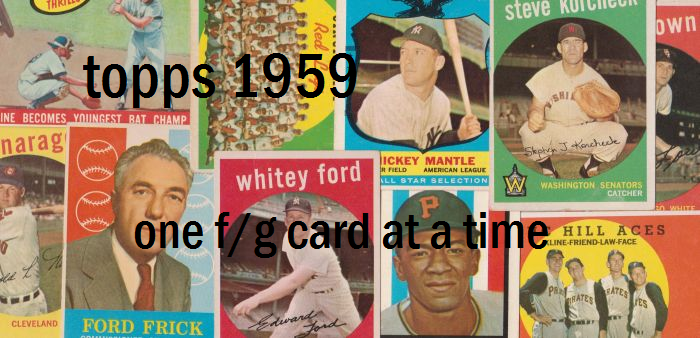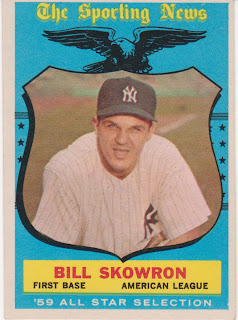Back in May I
featured this card and I tried to figure out what game that Rocky Colavito's catch occurred in. I set out wandering the 'Net looking for the original picture hoping to get the info from a caption or from a site itself. I found the original b/w shot but it wasn't accompanied by any info. Using the clues that Topps included I tried to track down the box score on Retrosheet or Baseball Reference.
Here is that card again:
I wasted a lot of time. And I came up empty. I'd googled the picture every way I thought possible. I double and triple checked every likely box score of Indian games at Yankee Stadium during Colavito's time with the Tribe. I had some games I thought to be possibilities but they never completely matched up with the scenario the cardback provided. I
was able to narrow the range because of the uniform Colavito had on.
Then, today, I hit paydirt while I wasn't even really digging. I was searching for a picture (a sequence actually) of a Duke Snider catch that's shown on another of the Baseball Thrill subset cards. A link to Corbis turned up dozens of Snider shots from the mid to late 50s's. Then it hit me. Try searching 'Colavito' within Corbis. Bingo. I found the picture again, and this time it had a caption:

Portrait of Rocky Colavito Original caption: Despite the efforts of a youngster wearing a baseball glove and trying to make the catch himself (right), Cleveland outfielder Rocky Colavito dashes along the right field, stands to make a one-hand catch and rob Gil McDougald of a home run in the 6th inning of the Yankee-Cleveland game here May 10th. Behind the strong hurling of veteran pitcher Bob Lemon, the Indians topped the Yanks, 7-2, and moved into second place in the league standings.
© Bettmann/CORBIS |
Photographer: Unknown
Creator: Unknown
Date Photographed: May 10, 1956
Location Information: New York, New York, USA |
Whoopee! I had the game nailed now:
May 10, 1956.
But how had I missed it before? Let's go back to the card itself, look at the back and see what 'clues' Topps gave me:
What the card claims:
a) It was late in the game.....
b) the Cleveland starter was tiring fast and....
c) he had already given up two hits..
d) the Indians led by
one run.
What the facts actually were according to the original caption and the boxscore:
a) It was the 6th inning, I wouldn't consider the sixth to be 'late' but I'll concede that point to Topps....
b)
Bob Lemon had allowed two singles and two walks. Thats four runners total at this point (one out in the sixth) and he went on to pitch a complete game. It was only his fifth start of the year and he was on four days rest. He was one of the most durable pitchers of his era and he led the league in complete games five time
including 1956! How tired could he have been at this point?
c) he'd given up two hits alright,
2 hits total. Topps makes it sound as if they were in that inning when in fact McDougald was the second hitter of the inning after Bauer led it off with a ground out, and...
d) the Indians led 4-0,
not by a single run. In fact, the only one run lead came in the middle of the Indians three run third inning. They were never even challenged after that.
It's no wonder I couldn't find it. Hell, Topps damn near made it up! Actually, as I noted in the original May post, the
previous day's game, a 6-5 Indian win seemed more likely since Colavito had made the final out in rightfield in the last inning of a one run game.
I realize that nobody in the world cares about any of this except me, but I'm going to go celebrate!
Another Update
I don't normally do this but I wanted to point out a nice interview that was posted on
Dinged Corners a few years back with two of
Moe Drabowsky's daughters. I just found it the other day while hunting for other stuff and thought I'd link to it given the Drabowsky post of a few days back.



















































